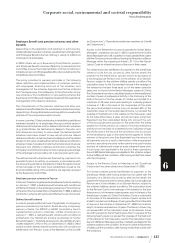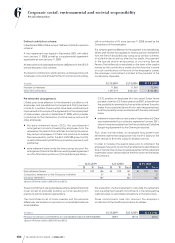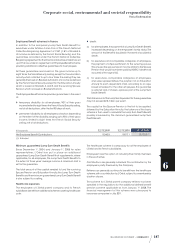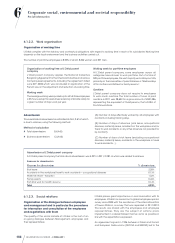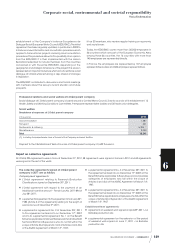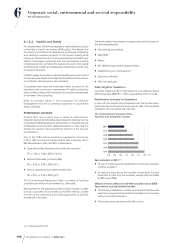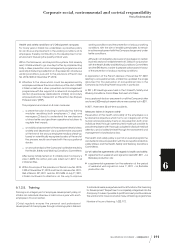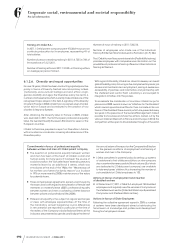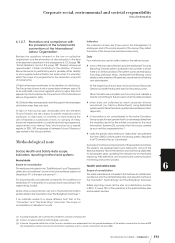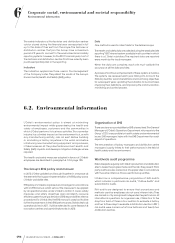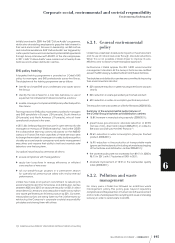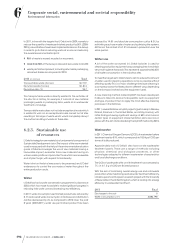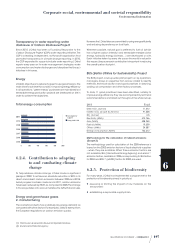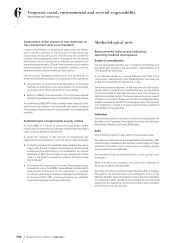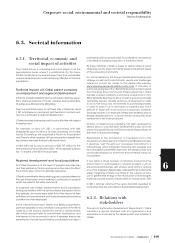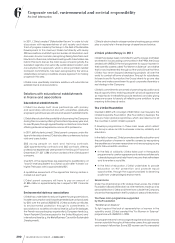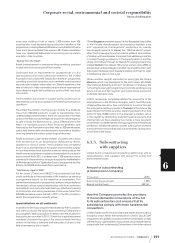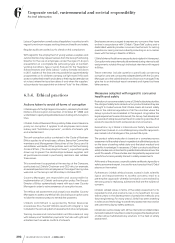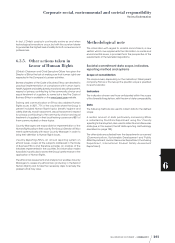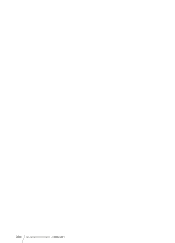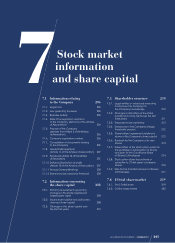Loreal 2011 Annual Report Download - page 197
Download and view the complete annual report
Please find page 197 of the 2011 Loreal annual report below. You can navigate through the pages in the report by either clicking on the pages listed below, or by using the keyword search tool below to find specific information within the annual report.
195REGISTRATION DOCUMENT − L’ORÉAL 2011
Corporate social, environmental and societal responsibility
6
Environmental information
Initially launched in2009, the EHS “Culture Audits” programme,
which aims at enabling employees to grasp the risks inherent in
their work environment, focuses on leadership, an EHS culture
and industrial excellence. EHS “Culture Audits” are triggered by
a site’s performance and conducted by internal EHS specialists
through Group interviews with 20-30% of the site’s employees.
In2011, EHS “Culture Audits” were carried out at twenty-three
factories and fourteen distribution centres.
EHS policy training
A targeted training programme is provided on L’Oréal’s EHS
policy for managers and EHSprofessionals across the Group.
The objectives of this training programme are as follows:
♦identify and share EHS vision, challenges and values across
the Group;
♦identify the risks inherent in a role, task, behaviour or use of
equipment and implement tailored corrective solutions;
♦enable managers to implement EHS policy effectively within
their teams.
Training sessions in EHS policy have been provided to managers
and EHS specialists in Europe (134people), South America
(24 people) and North America (19 people), who all have
operational functions in this area.
In2011, 42 L’Oréal participants took part in open seminars for site
managers on the topic of “EHS & leadership”, held at the CEDEP,
the collaborative learning community based on the INSEAD
campus in France. The main objectives of these seminars were
to change the mindset of managers on safety, build recognition
of safety as a core issue for companies and senior management
executives, and improve their ability to instil and maintain safe
behaviour over the long term.
Our global industrial policy demands all sites to:
♦ensure compliance with the regulations;
♦apply best practices in energy efficiency or efficient
consumption of resources;
♦roll out breakthrough projects in a permanent search
for operational performance allied with environmental
performance.
L’Oréal has made an important commitment to reducing its
environmental footprint for its factories and distribution centres
between2005 and2015: an absolute reduction of 50% in direct
and indirect CO2 emissions and a reduction in water consumption
and waste generated per finished product by 50%. Concrete,
measurable actions are being taken by the L’Oréal teams by
reinforcing the Company’s corporate societal responsibility
principles and sharing them with others.
6.2.1. General environmental
policy
L’Oréal has undertaken to reduce its impact on the environment
and its use of natural resources through absolute reductions.
When this is not possible, L’Oréal strives to improve its eco-
efficiency and to adopt a more ecological approach.
Furthermore, L’Oréal applies the ISO14001 environmental
management standard. All the Group’s factories are certified
except the BRI Lassigny, Galderma Brazil and Russia factories.
The factories and distribution centres are committed to improving
their environmental indicators:
♦50% absolute reduction in greenhouse gas emissions (scopeI
andII);
♦50% reduction in waste generated per finished product;
♦50% reduction in water consumption per finished product.
The reductions are calculated on a like-for-like basis (2005-2015).
Summary of the environmental performances of
theL’Oréal Group’s factories and distribution centres:
♦15.8% increase in manufacturing capacity (2005-2011);
♦greenhouse gas emissions: absolute reduction of 29.8%
(tonnes of CO2, direct and indirect, 2005-2011) on a like-for-
like basis according to the GHG Protocol
(1);
♦22.6% reduction in water consumption (litres per finished
product, 2005-2011);
♦16.9% reduction in the production of transportable waste
(grams per finished product including returnable packaging,
at the factories and distribution centres 2005-2011 );
♦the waste recycling rate has increased from 89.1% in2005 to
95.7% in2011, with 17factories at 100% in2011;
♦absolute improvement of 15.9% in the wastewater quality
index (2005-2011).
6.2.2. Pollution and waste
management
For many years, L’Oréal has followed an ambitious waste
management policy. This policy goes beyond regulatory
compliance and the prevention of human risks to the environment
and consists of waste prevention, recycling and reuse and energy
recovery in order to avoid waste to landfill.
(1) Greenhouse G as Protocol: international method of carbon accounting.


